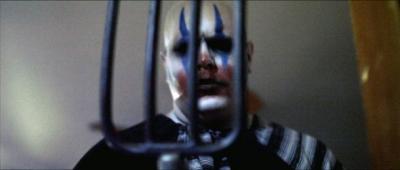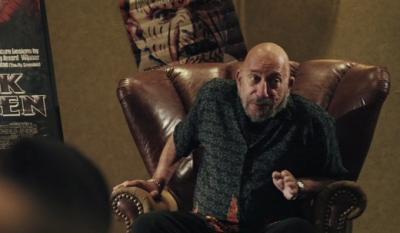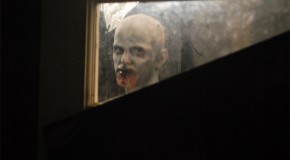By: debbie lynn elias
What happens when a horror movie becomes more than a movie? What happens when the thrill and excitement of heart-pounding fear one gets when watching a horror film just isn’t enough? What do you do next? Where do you get that next rush? What happens when you start to live out a horror film? And what horror film would you want to live out? These are some of the questions posed by writer/director Douglas Schulze and co-writer Joshua Wagner that give birth to MIMESIS.
In short, the definition of “mimesis” means “to imitate”. And that’s exactly the premise for MIMESIS – psycho crazed horror fans who “imitate” a horror movie using unsuspecting horror fans as their “victims”. And what better film to imitate than the granddaddy of them all, George Romero’s Night of the Living Dead.
The day begins with Russell and Duane in horror heaven at a local horror convention. With orgasmic glee, Russell can barely contain his excitement at the prospect of meeting his favorite director, the legendary Alfonso Betz. Somewhat embittered, Betz delivers an impassioned speech to his faithful followers, opining about society and the degradation of the horror film as “today’s sicko wants the real thing.” Little do Betz, or Russell and Duane, know just how real things are about to get.
Thanks to a serendipitous meeting with the goth Judith, Russell and Duane find themselves, along with several others, invited to an “exclusive” convention after-party. Heading out to a secluded location, Duane is more than a little hesitant while Russell is gung-ho for party time. But what kind of party is this as it doesn’t take long before everyone passes out, waking up in the morning to find themselves dressed in 60’s clothes with a black & white tv in a rundown farmhouse looping Night of the Living Dead. This is no party. This is a game, a sick game of survival that mimics Night of the Living Dead. Here’s where your horror history counts.
Cast alongside horror veterans like Sid Haig and Bill Hinzeman, are relative newcomers Allen Maldonado, Taylor Piedmont and David G.B. Brown, as Duane, Russell and Keith. Maldonado just nails his role both as Duane and as homage to his character’s inspiration from Night of the Living Dead. Particularly effective is David Gries who is a malevolent delight as ringleader “zombie”, Patrick.
Technically, Schulze and cinematographer Lon Stratton, cast a visual spell that, while paying homage to the lensing style of Romero, breaks the mold with distinctive yet fully integrated looks and tonal bandwidth. Lighting is particularly effective in its play shadows lending to a harder, harsh edge in keeping with the brutality of the horror.
Fraught with fun and fear, MIMESIS is a “must see” for horror fans. Rooted in cinematic history, paying loving homage to not only George Romero, but other horror icons, with MIMESIS, writer/director Douglas Schulze ups the horror ante with an exciting fresh spin on tried and true classics to delicious result.
A horror fan myself, as with Schulze, at the root of my excitement for MIMESIS is its initial building block – Night of the Living Dead. Not only did I see the film at a very young age on its release back in the 60’s, but I had the added bonus of taking my lunch to school for a couple of years in Night of the Living Dead promotional lunch bags. White airline plastic-lined vomit bags hand stamped with the film’s poster, it didn’t get more exciting than that when it came to grossing people out! And I am happy to say, Schulze brings some of that same excitement to MIMESIS. I had a chance to speak with him about this excitement in this exclusive one-on-one interview about MIMESIS, horror and, of course, band-aids.

Doug, I had so much fun watching this movie. I was a huge fan at 10 years old of George Romero’s Night of the Living Dead. My dad let me see it and I thought it was the coolest thing on the planet.
Same here!
So to see what you‘ve now done – this is a very refreshing spin that you‘ve put on not only Night of the Living Dead, but the horror genre as a whole. What is the attraction for you with Night of the Living Dead that led you to MIMESIS?
The concept for the film came first. The idea that there are extreme horror fans that tire of watching their favorite horror films so they set out to live them – that was the basic premise for MIMESIS. Then we had the arduous task of deciding what classic horror film with these extreme role players [would we] set out to recreate. For me, you have the slasher films, guys wielding, psychopaths with swords and axes and thins, and Freddy Kruegers, and I thought there wasnothing more horrific than the idea of a flesh-eating zombie. I still think that to this day. So there was nowhere else I needed to turn but to George Romero’s first classic, the granddaddy of them all, Night of the Living Dead. That’s how it all came together.

Being a fan of horror films, both on my end and your end, do you find that to make a really good horror film a filmmaker needs to be a fan to really understand and appreciate the nuance?
Yea. Yea. They say write what you know about and I think that‘s true in any discipline and any art form. I’m sure there are some brilliant filmmakers who could step into the genre and probably tackle it, but the more you approach things from having a passion and good understanding about it, the better the work will be. I grew up watching all the classics. I’m a fan first and foremost and this film to me is really an homage, if you will, to what I feel is one of the great horror classics of all time.
You‘ve got two very legendary actors in MIMESIS. You’ve got Sid [Haig] and Bill [Hinzman]. How hard was it to get the two of them to come on board for this or, alternatively, how excited were they about this fresh concept?
[laughing] Bill, as you know, passed away. Bill, for many years, is screendom’s first and most legendary zombie. He’s the graveyard zombie in Night of the Living Dead. And we thought it very apropos to invite Bill to participate in the making of MIMESIS. We knew that Bill was ill at the time. I’d always wanted to work with him and I would see him yearly in the horror convention circuit, so when the project came about I approached him. He drove into town, spent the day on set and it was just wonderful. Sid on the other hand brings a wealth of cinematic history to him. Hefs worked with legendary directors and hefs got such a cult following. I was a little starstruck when I met him first. Although he’s an imposing, tall man, very big, he’s probably one of the kindest, sweetest men you’ll ever meet. We just had a wonderful time on set with him. He was great.

What’s very interesting is here you have Haig seated for the bulk of his scenes so we really don‘t get the imposition of his physicality with this character. It all comes from the emotion with the preaching and speeches he‘s doing which are very powerful and great social commentary.
Thanks. The idea wasn’t to set out and just do exploitation, taking the concept. There‘s some social commentary in here and actually being a fan of George Romero’s Night of the Living Dead, there‘s social commentary there as well. We felt that to add that to the story to honor that tradition, if you will.
With your casting here, but for Sid and Bill, you have relative novices but for a tv appearance here and there and whatnot. But, I have to say, you have a couple of real standouts. Taylor [Piedmont] stands out and makes an impression but Allen Maldonado as Duane is amazing, as is David Gries with “Patrick”, which we don‘t really find out who he is until the climax of the film. Allen is very compelling, and it surprised me. How did you go about casting for these very different personalities, some of which are also stereotypical for a horror film but, again, you take it a step beyond and you step out of the stereotype.
What’s interesting is every actor you name there comes from a different state or actually, here in Michigan, from different parts of the state. Taylor was an actor in Michigan while Allen hails from Los Angeles and David was in Chicago and then he’s over in Grad Rapids, Michigan, so they came from different parts of the country to be in the film. Taylor had a bit of a history with so casting him [as Russell], when we did the auditions he showed up with the glasses and I immediately saw him as the striking resemblance to the “Johnny” character in Night of the Living Dead and thought he was great. Allen kind of made the cut. We went through several hundred potentials. There were a few choices that looked a bit closer to the Romero lead, but Allen, from a performance standpoint, just knocked it out of the park. A diverse group for sure.

Now your make-up. You’ve got varying degrees of it. Some looks a little “made-up” but then you get to somebody like “Patrick” and the make-up is absolutely phenomenal. It is textured, it is subtle, it is shadowed. Who did you use and how did you go about designing the zombie make-up?
It was a woman. Our special make-up effects girl is Cat Bernier. She’s a Chicago make-up effects artist. I’ve worked with Cat before on a movie I did called Dark Fields that featured David Carradine in it. So, I’ve got a rapport with Cat and I felt she was perfect for this type of make-up. When it came to creating the zombies – these are role players. We didn’t want them to be putting heavy prosthetics on because they’re more about the experience, more about playing zombie and literally wanting to do harm to others than they are the real die-hard traditionalists that will sit in front of a make-up mirror and put prosthetics on for hours. We had a long talk about that to come to that conclusion.
It‘s fabulous. As I said, with the character of “Patrick”, the shading and subtlety with the head is magnificent. I think part of what shows it off so well is Lon Strattonfs cinematography. I‘ve seen some of his other work and I just love what he does. How did the two of you go about developing your tonal bandwidth from a visual standpoint? Itfs very distinctive between day, night , interior and exterior. Very different looks but they all feel a part of the same thing.
Lon and I have worked on a previous film together. Lon’s just a brilliant cinematographer. We talked and he wanted to shoot this anamorphic so the film is actually in 2:35, traditional anamorphic format. It was a challenge to him working with an extremely light format in an isolated space. We studied the Romero film and both agreed to try to stay true to the classic in letting harsh shadows play a heavy role in the lighting of scenes. Minimal lighting, not overdoing scenes, would help retain a sense of realism. I think it works on that level. We had a wonderful collaboration. Lon’s a true professional.

It is visually immersive and I think a lot of what also comes into play is that you use a lot of really interesting camera angles. Everything is not very symmetrical or perfectly framed. You‘ve got some very angular edging going on with the framing. Did you storyboard this out, shot list it, and how collaborative were you with Lon in actually designing some of these specific shots?
That’s great! You normally don’t get asked this kind of detailed question from a reporter, so I appreciate it! I did an entire animatic for the film. For those that don’t know what an animatic is, it‘s actually an animated storyboard. Every shot was preconceived and then it was thrown into a timeline for pacing purposes. So you could literally sit down and watch my crude animatic of the film beforehand. I did all my own storyboards and I showed that to Lon. We had that onsite as a reference point for us. The “Dutch angles” that you were referencing, the off-kilter camera angles, are really an homage to the original George Romero film where he utilized a lot of that and he utilized a lot of wide angle master shots. We tried to do some emulation while still providing contemporary movement with dollies and things like that.
It is very free-flowing.
Yea. Exactly.

How hard was it to find the actual farmhouse where you shot this and how confining was the space within or did you do any build-outs outside of the structure?
We built the basement on a set.
I actually run a small studio here in a Michigan that’s part of a film school and we built the basement off set. But the farmhouse is a farmhouse. We found a few in Michigan but the problem was that they were inhabited and people don’t really want to relinquish their farmhouse to a movie. It took some doing to find one that was literally abandoned. The one we did find took a few months to find but they are here. In Michigan there are plenty of rural farmhouses for sure and we felt this one had the perfect look in what we were looking for. It was a nice find for us.
When will we see MIMESIS 2?
The sequel? We’ve got two scripts right now and wefre talking to our distributor Anchor Bay. We’re gearing up for what would be a late summer production. It would probably be seen perhaps this time next year if we’re lucky. So, wefll see what happens.
I would be remiss not to ask about the Motion Picture Institute. Summarize that for me in a nutshell as to what you do and what you accomplish.
You can certainly look us up at www.mpifilm.com. We’re Michigan’s oldest and most reputable trade school. We’ve been around for bout 15 years. We really thrive on teaching the technical and creative art of independent filmmaking, making films outside the studio system. We have some very successful graduates. We have numerous grads all around the country doing wonderful things. We’ve got our own little studio hub here in Michigan making movies. That’s what we love to do.

One last question and I have to ask “Why?” I‘ve noticed this for decades. Why is there never a first-aid kit or band-aid in sight in a good zombie movie? I think they would add such a humorous element!
Yea, right! [laughing] It’s interesting you should ask because there certainly was one on set behind the scenes. We did have a – long story shot – we had a scene where a hand literally goes through a plate glass window and we had a severe injury on set, which happens occasionally. We were fortunate enough to have a very good first-aid kit. We rushed the actor, Taylor [Piedmont] by the way, to an area hospital where he got stitches and literally came back to set the same day to continue filming. As far as why they’re not creatively not in the story line, that’s a good question. Maybe we’ll consider that for the sequel, for sure.
#
Read my review of MIMESIS…











